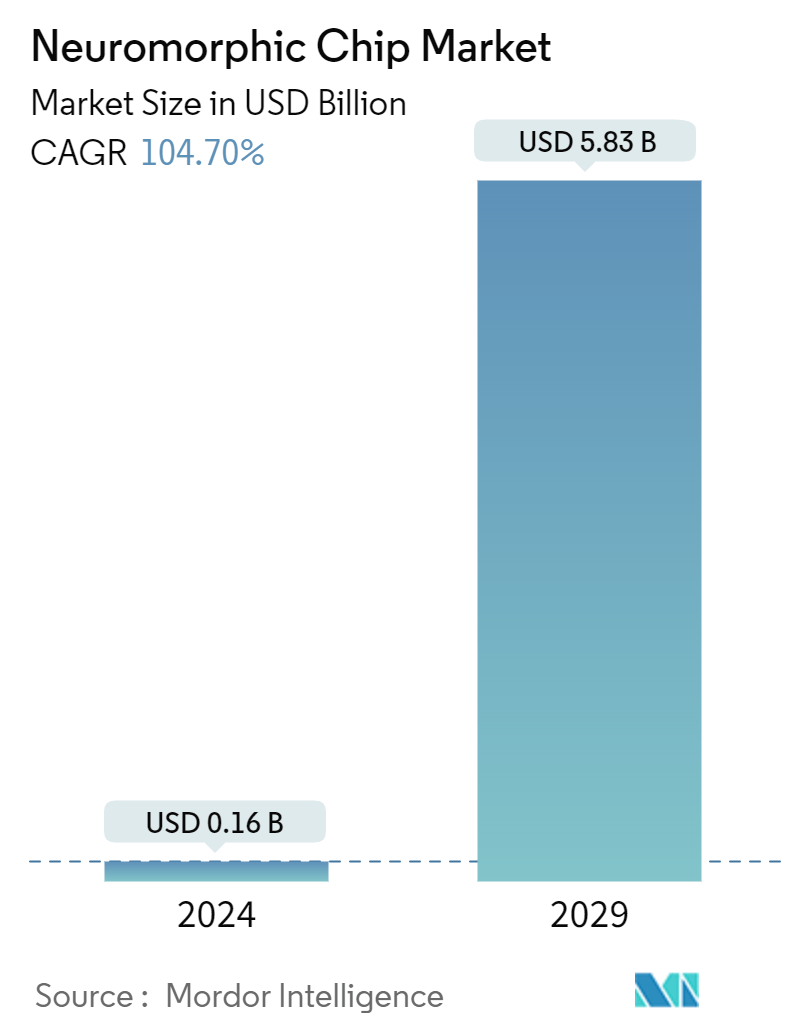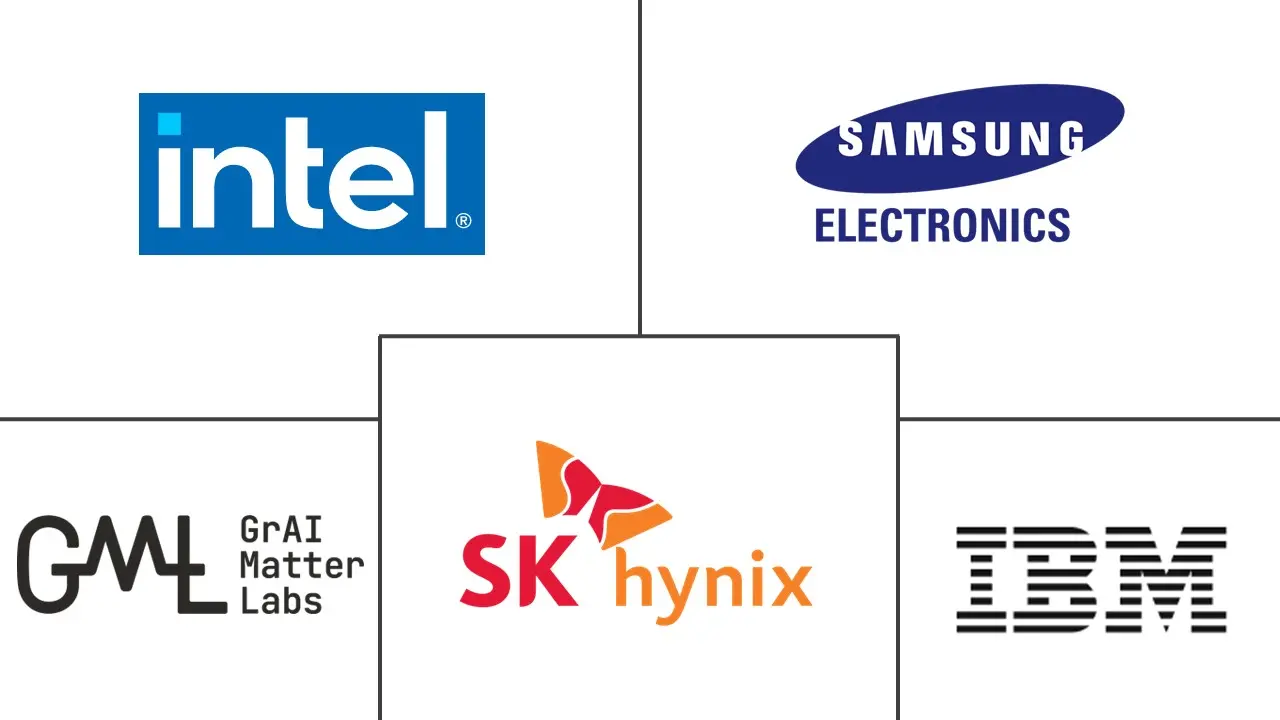Market Size of Neuromorphic Chip Industry

| Study Period | 2019 - 2029 |
| Market Size (2024) | USD 0.16 Billion |
| Market Size (2029) | USD 5.83 Billion |
| CAGR (2024 - 2029) | 104.70 % |
| Fastest Growing Market | Asia-Pacific |
| Largest Market | North America |
| Market Concentration | Medium |
Major Players
*Disclaimer: Major Players sorted in no particular order |
Neuromorphic Chip Market Analysis
The Neuromorphic Chip Market size is estimated at USD 0.16 billion in 2024, and is expected to reach USD 5.83 billion by 2029, growing at a CAGR of 104.70% during the forecast period (2024-2029).
• The increasing use of biometrics and in-speech recognition drives the demand for neuromorphic chips in smartphones. These chips are used to process audio data in the cloud and then return it to the phone. In addition, Artificial Intelligence (AI) requires more computing power, but low-energy neuromorphic computing could significantly push applications that run presently in the cloud to run directly in the smartphone in the future without substantially draining the phone battery.
• Neuromorphic is a specific brain-inspired ASIC that implements the Spiked Neural Networks (SNNs). On average, it has an object that can reach a massively parallel brain processing ability in tens of watts. The memory and the processing units are in single abstraction (in-memory computing).
• This leads to the advantage of dynamic, self-programmable behavior in complex environments. Instead of traditional bit-precise computing, neuromorphic hardware leads to the probabilistic models of simple, reliable, robust, and data-efficient computing as the brain's highly stochastic nature. Neuromorphic hardware certainly suits more cognitive applications than precise computing.
• During the next decade, neuromorphic computing will transform the nature and functionalities of a wide range of scientific and non-scientific applications. Some of them include mobile applications that are increasingly demanding powerful processing capacities and abilities.
• The design of neuromorphic chips follows the goal of modeling parts of the biological nervous system. The aim is to reproduce its computational functionality, especially its ability to efficiently solve cognitive and perceptual tasks. Achieving this requires modeling networks of sufficient complexity regarding the number of neurons and synaptic connections. The brain and its ability to learn and adapt to specific problems are still subject to basic neuroscientific research.
• The telltale spike in energy demand resulting from neuromorphic computing devices using potentially very small quantities of electricity makes hardware attacks much easier to identify. This increase would be visible through side-channel monitoring. Neuromorphic device designers may use brain functionality as a blueprint to create computing systems that use 3D nanostructures, biomaterials, redox memristors, magnetic neural network crossbar arrays, and other technologies.
• The COVID-19 pandemic had a favorable influence on the medical business market. Several market leaders, including IBM, Hewlett Packard, and Qualcomm, pushed their neuromorphic computing solutions into several hospitals and clinics worldwide. Their technologies' computational skills were able to reduce various difficulties inside a normal hospital ecosystem. The pandemic kept the capital equipment sector humming with a strong demand for next-generation electronics.
Neuromorphic Chip Industry Overview
Neuromorphic chips are digitally-processed analog chips with a series of networks similar to human brain networks. These chips contain millions of neurons and synapses to augment self-intelligence, irrespective of pre-installed codes in normal chips. Neuromorphic chips, as a special kind of chip, can manipulate data received through sensors. For the study, chips that adopt the SNN approach have been considered part of the scope. The market studied tracks deep learning hardware and neuromorphic chips as separate markets.
The Neuromorphic Chip Market is segmented by End-User Industry (Financial Services & Cybersecurity, Automotive (ADAS/Autonomous Vehicles), Industrial (IoT Ecosystem, Surveillance, and Robotics), Consumer Electronics), Geography (North America, Europe, Asia Pacific, Rest of the World). The market sizes and forecasts are provided in terms of value (USD) for all the above segments.
| By End-User Industry | |
| Financial Services and Cybersecurity | |
| Automotive (ADAS/Autonomous Vehicles) | |
| Industrial (IoT Ecosystem, Surveillance, and Robotics) | |
| Consumer Electronics | |
| Other End-user Industries (Medical, Space, Defense, Etc.) |
| By Geography | |
| North America | |
| Europe | |
| Asia Pacific | |
| Rest of the World |
Neuromorphic Chip Market Size Summary
The neuromorphic chip market is poised for significant growth, driven by the increasing demand for advanced computing solutions that mimic the human brain's processing capabilities. These chips, which utilize spiked neural networks, offer advantages in dynamic, self-programmable behavior and are particularly suited for cognitive applications. The market is experiencing a surge in interest due to their potential in mobile applications, wearable devices, and artificial intelligence, where they can enable high-performance computing with ultra-low power consumption. The consumer electronics industry, in particular, sees neuromorphic computing as a promising tool to enhance the functionality of devices like smartphones and wearables, allowing for intelligent processing without relying heavily on cloud computing.
North America is a key region for the neuromorphic chip market, with major vendors like Intel and IBM leading the charge. Government initiatives and investments, such as those from the US National Science Foundation and Canada's focus on artificial intelligence, are fostering growth in this sector. The market is characterized by a consolidation of large-scale semiconductor vendors, architecture-development start-ups, and academic institutions, all contributing to research and development efforts. Despite being in the early stages, the market is witnessing increased patent activity and collaborations aimed at advancing neuromorphic technology. Notable developments include partnerships and innovations by companies like BrainChip Holdings and Intel, which are pushing the boundaries of what neuromorphic computing can achieve in various applications.
Neuromorphic Chip Market Size - Table of Contents
-
1. MARKET INSIGHTS
-
1.1 Market Overview
-
1.2 Industry Attractiveness - Porter Five Forces
-
1.2.1 Bargaining Power of Suppliers
-
1.2.2 Bargaining Power of Buyers
-
1.2.3 Threat of New Entrants
-
1.2.4 Threat of Substitute Products
-
1.2.5 Intensity of Competitive Rivalry
-
-
1.3 Industry Value Chain Analysis
-
1.4 Emerging Use Cases for Neuromorphic Chips
-
1.5 Assessment of the Impact of COVID-19 on the Market
-
-
2. MARKET SEGMENTATION
-
2.1 By End-User Industry
-
2.1.1 Financial Services and Cybersecurity
-
2.1.2 Automotive (ADAS/Autonomous Vehicles)
-
2.1.3 Industrial (IoT Ecosystem, Surveillance, and Robotics)
-
2.1.4 Consumer Electronics
-
2.1.5 Other End-user Industries (Medical, Space, Defense, Etc.)
-
-
2.2 By Geography
-
2.2.1 North America
-
2.2.2 Europe
-
2.2.3 Asia Pacific
-
2.2.4 Rest of the World
-
-
Neuromorphic Chip Market Size FAQs
How big is the Neuromorphic Chip Market?
The Neuromorphic Chip Market size is expected to reach USD 0.16 billion in 2024 and grow at a CAGR of 104.70% to reach USD 5.83 billion by 2029.
What is the current Neuromorphic Chip Market size?
In 2024, the Neuromorphic Chip Market size is expected to reach USD 0.16 billion.

